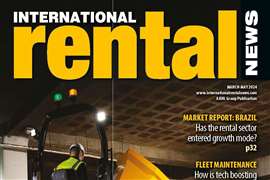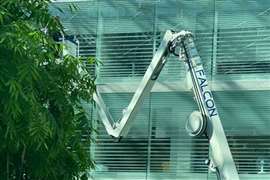On track
23 April 2008
The charge is being led by the equipment manufacturers, with companies including Komatsu, Caterpillar, JLG Industries, JCB, Atlas Copco and Merlo among those to be offering customers the option of a factory-installed telematics solution.
The recent moves by both JCB (with its ‘LiveLink' offering) and JLG (‘ClearSky') to offer telematics are instructive, because both companies have chosen quite similar solutions. In each case, the manufacturers are partnering with specialist telematics firms, Qualcomm in JCB's case and MasterTrak with JLG, and in both cases customers will be able to access a wide range of machine operating data by accessing a secure section of the manufacturers' own websites. Both systems use a mix of mobile phone and satellite (GPS) communication systems to track and transmit the data.
With JCB LiveLink, the telematics unit is hard wired into the machine's electrics, giving owners access to a wide range of operating data and the ability to ‘geofence' machines, set operating curfews and trigger service alerts.
JCB's chief operating officer, Matthew Taylor, says; "JCB Livelink provides our customers with an extremely high-tech system which will help them run their businesses more efficiently and profitably by providing productivity and also by enhancing servicing."
LiveLink can be purchased either with the machine or as a retrofit from JCB dealers. JCB's aftermarket product manager, Paul Hemingway, tells IRN that customers will not have to pay an upfront cost for the technology, but will pay an as yet unspecified monthly licence cost for each machine, payable to Qualcomm.
JLG's system, meanwhile, which can also be factory- or retro-fitted, uses a telematics control unit developed by Illinois-based telematics specialist MasterTrak to provide a two-way communication link to a machine's control system. The system will provide users - via a secure web page - with information including:
• On-demand diagnostics and troubleshooting;
• Preventative maintenance alerts based on real operating data;
• Remote turn-on and turn-off;
• Theft deterrent and recovery;
• Geo-fencing and GPS mapping.
JLG emphasises the benefits to rental fleet owners, saying that, for example, they will be alerted to a problem before the point of failure, meaning that a service engineer can be on site with the correct part to minimise any down time. JLG can also ‘ping' the machine itself, at the request of the owner, and try to identify any problems.
"These capabilities can save time and money by eliminating unnecessary trips to the field, and they allow service technicians to arrive equipped with the right tools, parts and training so they are more effective", says JLG.
Rental companies will also enjoy the benefits of knowing if a machine has been used outside its contracted period, and owners can be alerted if the machine is being used beyond its safe operating parameters. This could have important safety and training implications, for example, identifying sites and users who would benefit from further training.
JLG's Scott Milligan, director, domestic inside sales and service, says pricing for the service has still to be determined, although the company is looking at fixed monthly costs based on telecommunications costs; "Nobody wants a potentially variable expense at the branch level", says Mr Milligan. He expects JLG's European customers to lead the way in adopting the technology.
What is particularly interesting about the manufacturer-led telematics systems is the wider potential benefits they can bring for manufacturers, and not just the rental company users.
The telematics systems offer manufacturers the opportunity to maintain contact with a machine over its working life. "It's about the OEMs ability to participate in post point-of-sale revenues", says Gregg Johnson, president of MasterTrak, "The OEMs are going to experience more revenue opportunities beyond point of sale. The dealers and service groups will get more as well."
JLG's choice of MasterTrak makes sense not just because of its evident expertise, but because MasterTrak recently signed an alliance with SmartEquip, the US company that has developed a web-based aftermarket support platform that links major equipment owners with their big equipment suppliers.
The SmartEquip system could provide an automatic link between data on faults and machine-hours generated by the MasterTrak Telematics and the recommended actions provided by the equipment manufacturer. The system will then be able to automatically create a work order for corrective action or preventative maintenance, linked to the manufacturers' aftermarket support systems.
Being able to track the history and performance of a machine in detail gives other potential benefits. Komatsu, for example, which recently extended the coverage of its Komtrax telematics system to all but the very smallest of its compact equipment range, says that experience from Japan, where Komtrax has been used on large equipment for over five years, shows that residual values can by 5% higher as a result of the detailed working history of the machine.
One can imagine a situation where manufacturers may also be willing to extend warranty periods and offer other benefits where they have access to detailed machine operating data.
Gregg Johnson of MasterTrak says there are wider implications for the manufacturers as well. Speaking generally - and not in the context of the JLG solution that MasterTrak is supplying - he says that access to machine data, and the confidence that gives about its performance and condition, opens the possibility for manufacturers to take a bigger stake in the machines themselves, effectively ‘renting' them to their customers, including rental companies themselves. "Within five years" he says, "we will have large OEMs owning rental company fleets."
Whether or not that turns out to be true, for the time being rental companies have to ask themselves simply if the benefits offered by the technology will justify the costs. Typical costs for these manufacturer-tied systems are in the US$20-40 range per unit per month, which is a sizeable investment. And they also have to consider the logistical implications of having several different manufacturer-led telematics solutions on their equipment.
Some have already decided that now is not the right time to making investments. Erik Olsson, president and chief executive officer of RSC Equipment Rental, the world's second largest equipment rental company, told IRN during ConExpo that "it is the future, certainly...Our big problem is that it's not one standard interface." He says RSC will not invest at the moment; "we're constantly saying, can we cost justify it?"
He makes the further point that "Manufacturers want data and want paid for it - I think the cost will come down."
Of course, rental companies don't need to opt for the OEM-supplied systems, although there are advantages in having the telematics wired into the machine's control systems because it gives the owner full access to the entire diagnostics and control systems in the unit.
Rental companies can instead choose to install a system of their choice on to their fleets, using the same supplier for the entire fleet, which has obvious benefits, even if the range of data available is less comprehensive. Both Qualcomm and MasterTrak, for example, will retrofit systems directly to a rental fleet, and there are a large number of other telematics suppliers who will do the same.
What is also clear is that these suppliers are aware that the price is putting rental companies off. Several are now offering lower-cost versions of their full systems. Qualcomm, for example, has launched a ‘Lite' version of its GlobalTRACS solution, targeted at smaller companies, and priced at around US$18/machine/month and with an initial $495 installation cost.
Although not giving all the data that the full version does, GlobalTRACS Lite still offers curfew, geofencing and hours worked data as well as location.
Already with over 12 years of experience in retrofitting monitoring systems to construction equipment is Rosler miniDaT Gmbh, in Germany. It has fitted 25000 of its miniDaT systems - 75-80% of these in Germany, where it is particularly well established within the aerial platform rental community - and is also targeting rental companies worldwide.
The firm's managing director and founder, Klaus-Dieter Rosler, tells IRN that its independence from the manufacturers is one of its selling points; "Customers will have a mixed fleet, and will have different [telematics] platforms side by side. Customers are more interested in one platform for remote monitoring."
He says the key things that rental companies are looking for is the working hours - often looking for work at weekends or triple shifts - and the ability to switch off the machine; "At the moment, around 95% of customers go for the basic information, but it's changing", he says.
The miniDaT records basic operating data and is then downloaded when it returns to the rental company's yard, or when the rental company makes a site visit. However, Rosler launched last year its new Obserwando version of the system, miniDaT-WEB, giving users web access to data. This comes at a €749 initial cost (or rented at €10/month) with additional €1/month or €3/month licence fee per unit depending on how often you need access to the data.
Another company soon to offer a lower cost telematics solution is Trimble Asset Management, with a ‘lite' version of its remote asset management system that was first introduced a few years ago. Trimble initially targeted sales activities at its core customer base - large earthmoving contractors - and although it has some rental customers in the US, has still to make any serious inroads into the European rental sector.
Peter Houghton, Trimble's European construction services manager, who is responsible for marketing the asset management solution in Europe, says the system uses a number of sensors placed on the machine to record operating functions. You can get automatic alerts on data including machine on and off, when the unit entered and left a site, as well as other information.
The full version has a number of service plans, each with their own costs, and prices also vary depending on how frequently the machine data is updated. The new lite version, however, will have a one-off installation cost of around €500-700 and a monthly licence fee of between €20 and €30 per machine.
"We definitely see rental as our market", says Mr Houghton, who adds that the company is looking at partnering with rental software and ERP software specialists to reach the rental market.
Of course, investing in a telematics solution is just the start of the story for rental companies. Doug Mitchell, founder of US rental technology consultant RentalMetrics, warns that simply watching ‘dots on a map' is largely irrelevant; "What is important is doing something with the data points that come from the systems". He says rental companies will "often neglect to mention that data integration from the tracking solution into their core systems is critical."
In other words, you have to think hard about how you will use the data before you become seduced by what's on offer.
Tracking highlights
GPS Insight has installed 500 GPS tracking units to the delivery trucks operated by Las Vegas, US based rental company Ahern Rentals. The web-based tracking and vehicle diagnostics system uses both Google Earth and Google Mobile mapping systems. It tracks a vehicle's location by using GPS satellite technology, and monitors the speed, odometer, fuel consumption and diagnostic trouble codes from the engine's computer, transmitting all the data in real time. The GPS unit is a "plug-n-play" system that is fitted to the vehicle's diagnostic port underneath the dashboard.
Caterpillar is to fit most of its core, mining and paving machines with its Equipment Manager and Product Link remote asset management system as standard. It has been an option on these machines since 1998. Product Link will be an option on other Cat models.
OEM Data Delivery in the US has developed a low-cost machine monitoring system, called GoPOD, which uses a small concealed computer in the machine to store machine data that is then retrieved by a receiver driven past the site within 300 ft of the machine. The data is formatted and then made available every day on a password protected website. The system is one of several new wireless systems that OEM Data Delivery has developed for the equipment rental sector.
A survey of customers by rental software company inspHire found that 40% didn't use any form of asset tracking system, mainly because they were viewed as being prohibitively expensive. The 60% who did use asset tracking did so primarily to protect their fleets and as an anti-theft measure.
UK rental companies A-Plant and HE Services are using Enigma Vehicle Systems' Skyline GPS tracking, security and telematics system to protect their fleets. The system uses GSM/GPRS communications network to report vehicle movements and ignition state, and a further eight input/output ports can be used to monitor sensors located for other machine functions.






